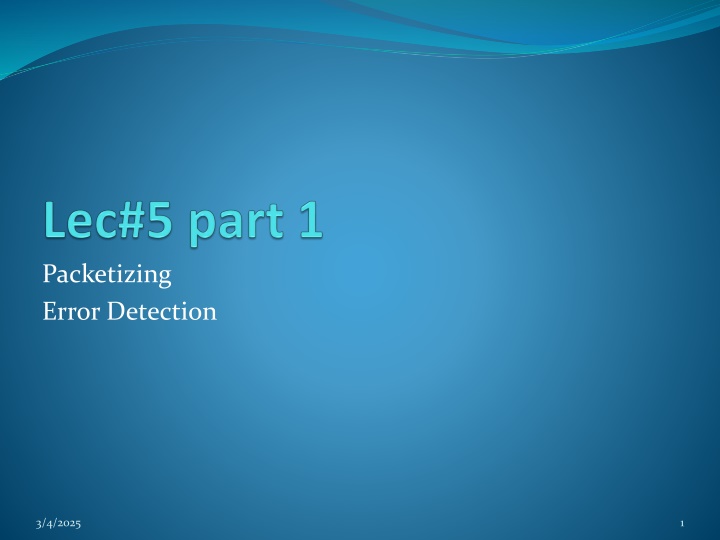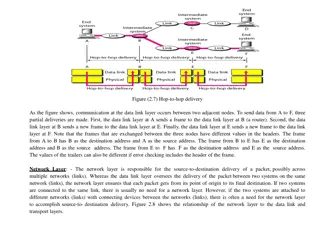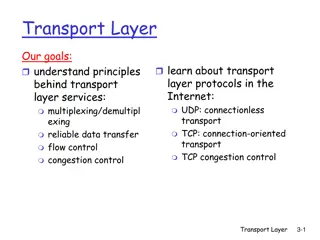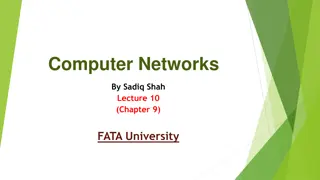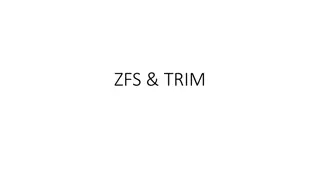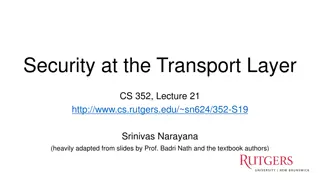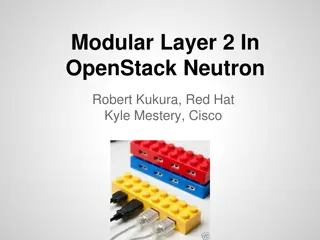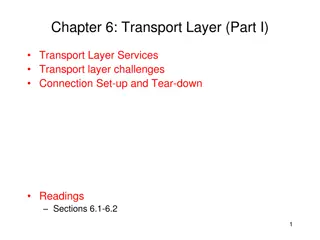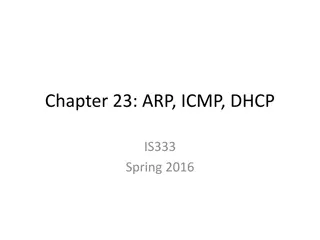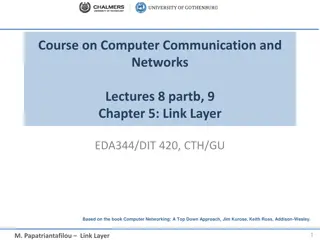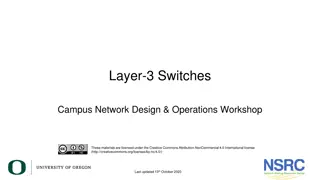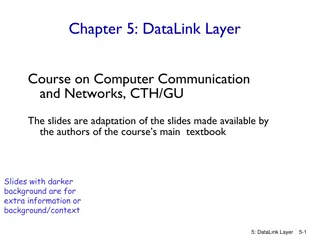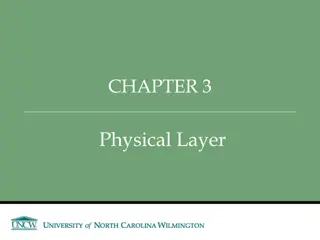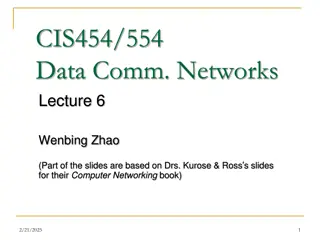Data Link Layer and Packetization
The data link layer plays a crucial role in network communication by managing packets' flow, error control, addressing, and more. Networks send data efficiently by breaking it into manageable packets and reassembling it at the destination. Discover the significance of packets and how they optimize network communications.
Download Presentation

Please find below an Image/Link to download the presentation.
The content on the website is provided AS IS for your information and personal use only. It may not be sold, licensed, or shared on other websites without obtaining consent from the author.If you encounter any issues during the download, it is possible that the publisher has removed the file from their server.
You are allowed to download the files provided on this website for personal or commercial use, subject to the condition that they are used lawfully. All files are the property of their respective owners.
The content on the website is provided AS IS for your information and personal use only. It may not be sold, licensed, or shared on other websites without obtaining consent from the author.
E N D
Presentation Transcript
Packetizing Error Detection 3/4/2025 1
The Data Link Layer Data link layer is responsible for carrying a packet ( called frame) from one hop to the next hop. Specific responsibilities of the data link layer include framing, addressing, flow control, error control, and media access control. 3/4/2025 2
3/4/2025 3
How Networks Send Data To send data over a network, the data is broken down into small, manageable packets , each wrapped with the essential information needed to get it from its source to the correct destination . In the sender, data is disassembled in small chunks. Then it reassemble in the proper order when it reaches its destination. 3/4/2025 4
The Function of Packets in Network Communications Networks cannot operate if computers put large amountsof dataon the cableat the same time. 3/4/2025 5
The Function of Packets in Network Communications There are two reasons why putting large chunks of data on thecable atone time slowsdown the network: Large amounts of data sent as one large unit tie up the network and make communications impossible because one computer is flooding thecable with data. 1. timely interaction and 2. The impact of retransmitting large units of data further multiplies network traffic. These effects are minimized when the large data units are reformatted into smaller packages for better management of errorcorrection in transmission. 3/4/2025 6
Components of Packets Packets contents are based on the protocol used , but they basically contain: Source address Destination address Data to be sent ( files & messages) Other information like: Giving instructions to the network on how to send data Telling the receiving computer how to collect and arrange packets. Checking data from errors (determine the need to resend the data) 3/4/2025 7
A Typical data packet on the Network error-checking component 3/4/2025 8
3/4/2025 9
Accuracy of the Transmitted Data Datacan becorrupted during transmission. For reliable communication, errors must be detected and corrected. 3/4/2025 10
Single-Bit Error In a single-bit error, only one bit in the data unit has changed. (0 1 or 1 0) 3/4/2025 11
Burst Error Two or more bits in the data unit have changed Burst error does not necessarily mean that the errors occur in consecutive bits Corrupted Bits = 4 bits 3/4/2025 12
Error Detection Error detection uses the concept of redundancy, which means adding extra (redundant) bits for detecting errors at the destination 3/4/2025 13
Error Detection Methods Three types of redundancy checks: Error Detection Methods Cycle Redundancy Check Parity Check Checksum 3/4/2025 14
Parity Check The most common and least expensive a parity bit (extra bit)is added to every data unit so that the total number of 1 s is even or odd. Simple parity check can detect single bit errors. It can detect burst errors only if the total number of errors in each data unit is odd. 3/4/2025 15
Even/odd parity Computers can sometimes make errors when they transmit data. Even/odd parity: is basic method for detecting if an odd number of bits has been switched by accident. Odd parity: The number of 1-bit must add up to an odd number Even parity: The number of 1-bit must add up to an even number 3/4/2025 16
Even/odd parity The computer knows which parity it is using If it uses an even parity: If the number of of 1-bit add up to an odd number then it knows there was an error: If it uses an odd: If the number of of 1-bit add up to an even number then it knows there was an error: However, If an even number of 1-bit is flipped the parity will still be the same. But an error occurs The even/parity can t this detect this error. 3/4/2025 17
Even/odd parity It is useful when an odd number of 1-bits is flipped. Suppose we have an 7-bit binary word (7-digits). If you need to change the parity you need to add 1 (parity bit) to the binary word. You now have 8 digit word. However, the computer knows that the added bit is a parity bit and therefore ignore it. 3/4/2025 18
Example (1) Suppose you receive a binary bit word 0101 and you know you are using an odd parity. Is there any error? The answer is yes: There are 2 1-bit, which is an even number We are using an odd parity So there must have an error. 3/4/2025 19
Parity Bit A single bit is appended to each data chunk makes the number of 1 bits even/odd 3/4/2025 20
Parity Checking Assume we are using even parity with 7-bit ASCII. The letter V in 7-bit ASCII is encoded as 0110101. How will the letter V be transmitted? Because there are four 1s (an even number), parity is set to zero. This would be transmitted as: 01101010. If we are using an odd parity: The letter V will be transmitted as 01101011 3/4/2025 21
Exercise 1 Suppose you are using an odd parity. What should the binary word 1010 look like after you add the parity bit? Answer: There is an even number of 1-bits. So we need to add another 1-bit Our new word will look like 10101 . 3/4/2025 22
Exercise 2 Suppose you are using an even parity. What should the binary word 1010 look like after you add a parity bit? Answer: There is an even number of 1 s. So we need to add another 0 Our new word will look like 10100 . 3/4/2025 23
Parity Check Sender Receiver 0 0 1 0 1 0 1 Data 0 0 1 0 1 0 1 Yes , Drop parity bit & accept data Reject Data No Even? Calculate Parity bit Count bits 0 0 1 0 1 0 1 1 0 0 1 0 1 0 1 1 Data + Redundancy Bits The Medium 3/4/2025 24
Cyclic Redundancy Check (CRC) Used for error checking Unlike the parity check which is based on addition, CRC is based on binary division. Before sending data ,some calculation are done on the data packets to generate a CRC number The CRC is calculated so the packet ( data + CRC ) becomes exactly divisible by a predetermined number. When data is received , the packet is divided by the number. 3/4/2025 25
Cyclic Redundancy Check (CRC) If the reminder 0 : data is correct If the reminder 1 : data has a problem and need to be sent again. CRC Can detect single bit & burst errors. 3/4/2025 26
Division in CRC encoder 3/4/2025 27
Division in the CRC decoder for two cases 3/4/2025 28
Checksum A checksum adds together chunks of data. A match between receiver checksum and transmitted checksum indicates good data. A mismatch indicates an error has occurred. Capable of detecting single or burst errors. It is simple to implement in either hardware or software. 3/4/2025 29
Checksum idea Suppose our data is a list of five 4-bit numbers that we want to send to a destination. In addition to sending these numbers, we send the sum of the numbers. For example, if the set of numbers is (7, 11, 12, 0, 6), we send (7, 11, 12, 0, 6, 36), where 36 is the sum of the original numbers. The receiver adds the five numbers and compares the result with the sum. If the two are the same, the receiver assumes no error, accepts the five numbers, and discards the sum. Otherwise, there is an error somewhere and the data are not accepted. 3/4/2025 30
We can make the job of the receiver easier if we send the negative (complement) of the sum, called the checksum. In this case, we send (7, 11, 12, 0, 6, 36). The receiver can add all the numbers received (including the checksum). If the result is 0, it assumes no error; otherwise, there is an error. 3/4/2025 31
